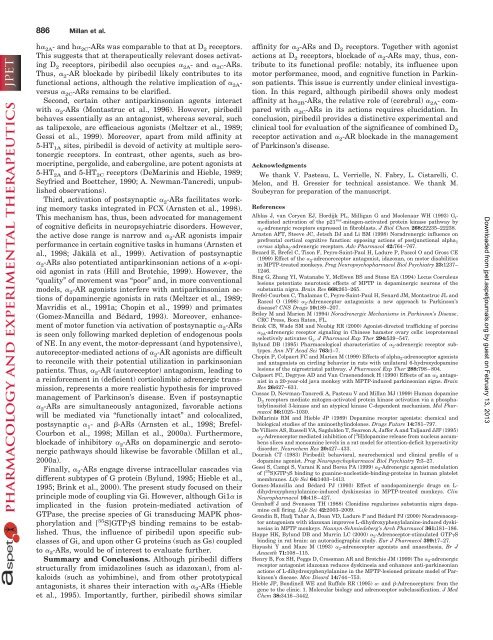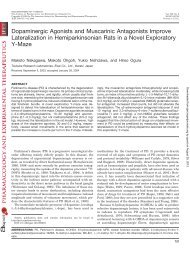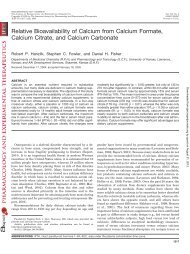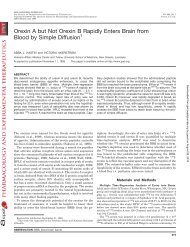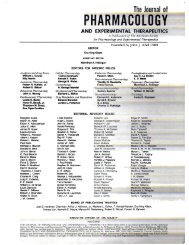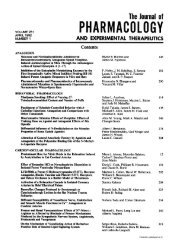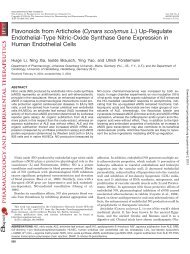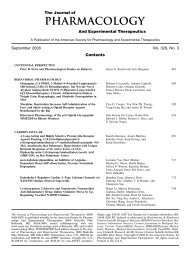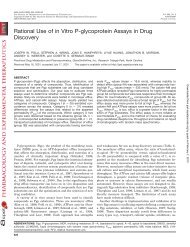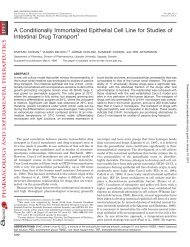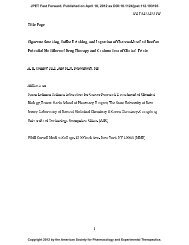Antiparkinsonian Agent Piribedil Displays Antagonist Properties at ...
Antiparkinsonian Agent Piribedil Displays Antagonist Properties at ...
Antiparkinsonian Agent Piribedil Displays Antagonist Properties at ...
You also want an ePaper? Increase the reach of your titles
YUMPU automatically turns print PDFs into web optimized ePapers that Google loves.
886 Millan et al.<br />
h� 2A- and h� 2C-ARs was comparable to th<strong>at</strong> <strong>at</strong> D 2 receptors.<br />
This suggests th<strong>at</strong> <strong>at</strong> therapeutically relevant doses activ<strong>at</strong>ing<br />
D 2 receptors, piribedil also occupies � 2A- and � 2C-ARs.<br />
Thus, � 2-AR blockade by piribedil likely contributes to its<br />
functional actions, although the rel<strong>at</strong>ive implic<strong>at</strong>ion of � 2Aversus<br />
� 2C-ARs remains to be clarified.<br />
Second, certain other antiparkinsonian agents interact<br />
with � 2-ARs (Montastruc et al., 1996). However, piribedil<br />
behaves essentially as an antagonist, whereas several, such<br />
as talipexole, are efficacious agonists (Meltzer et al., 1989;<br />
Gessi et al., 1999). Moreover, apart from mild affinity <strong>at</strong><br />
5-HT 1A sites, piribedil is devoid of activity <strong>at</strong> multiple serotonergic<br />
receptors. In contrast, other agents, such as bromocriptine,<br />
pergolide, and cabergoline, are potent agonists <strong>at</strong><br />
5-HT 2A and 5-HT 2C receptors (DeMarinis and Hieble, 1989;<br />
Seyfried and Boettcher, 1990; A. Newman-Tancredi, unpublished<br />
observ<strong>at</strong>ions).<br />
Third, activ<strong>at</strong>ion of postsynaptic � 2-ARs facilit<strong>at</strong>es working<br />
memory tasks integr<strong>at</strong>ed in FCX (Arnsten et al., 1998).<br />
This mechanism has, thus, been advoc<strong>at</strong>ed for management<br />
of cognitive deficits in neuropsychi<strong>at</strong>ric disorders. However,<br />
the active dose range is narrow and � 2-AR agonists impair<br />
performance in certain cognitive tasks in humans (Arnsten et<br />
al., 1998; Jäkälä et al., 1999). Activ<strong>at</strong>ion of postsynaptic<br />
� 2-ARs also potenti<strong>at</strong>ed antiparkinsonian actions of a �-opioid<br />
agonist in r<strong>at</strong>s (Hill and Brotchie, 1999). However, the<br />
“quality” of movement was “poor” and, in more conventional<br />
models, � 2-AR agonists interfere with antiparkinsonian actions<br />
of dopaminergic agonists in r<strong>at</strong>s (Meltzer et al., 1989;<br />
Mavridis et al., 1991a; Chopin et al., 1999) and prim<strong>at</strong>es<br />
(Gomez-Mancilla and Bédard, 1993). Moreover, enhancement<br />
of motor function via activ<strong>at</strong>ion of postsynaptic � 2-ARs<br />
is seen only following marked depletion of endogenous pools<br />
of NE. In any event, the motor-depressant (and hypotensive),<br />
autoreceptor-medi<strong>at</strong>ed actions of � 2-AR agonists are difficult<br />
to reconcile with their potential utiliz<strong>at</strong>ion in parkinsonian<br />
p<strong>at</strong>ients. Thus, � 2-AR (autoreceptor) antagonism, leading to<br />
a reinforcement in (deficient) corticolimbic adrenergic transmission,<br />
represents a more realistic hypothesis for improved<br />
management of Parkinson’s disease. Even if postsynaptic<br />
� 2-ARs are simultaneously antagonized, favorable actions<br />
will be medi<strong>at</strong>ed via “functionally intact” and colocalized,<br />
postsynaptic � 1- and �-ARs (Arnsten et al., 1998; Brefel-<br />
Courbon et al., 1998; Millan et al., 2000a). Furthermore,<br />
blockade of inhibitory � 2-ARs on dopaminergic and serotonergic<br />
p<strong>at</strong>hways should likewise be favorable (Millan et al.,<br />
2000a).<br />
Finally, � 2-ARs engage diverse intracellular cascades via<br />
different subtypes of G protein (Bylund, 1995; Hieble et al.,<br />
1995; Brink et al., 2000). The present study focused on their<br />
principle mode of coupling via Gi. However, although Gi1� is<br />
implic<strong>at</strong>ed in the fusion protein-medi<strong>at</strong>ed activ<strong>at</strong>ion of<br />
GTPase, the precise species of Gi transducing MAPK phosphoryl<strong>at</strong>ion<br />
and [ 35 S]GTP�S binding remains to be established.<br />
Thus, the influence of piribedil upon specific subclasses<br />
of Gi, and upon other G proteins (such as Gs) coupled<br />
to � 2-ARs, would be of interest to evalu<strong>at</strong>e further.<br />
Summary and Conclusions. Although piribedil differs<br />
structurally from imidazolines (such as idazoxan), from alkaloids<br />
(such as yohimbine), and from other prototypical<br />
antagonists, it shares their interaction with � 2-ARs (Hieble<br />
et al., 1995). Importantly, further, piribedil shows similar<br />
affinity for � 2-ARs and D 2 receptors. Together with agonist<br />
actions <strong>at</strong> D 2 receptors, blockade of � 2-ARs may, thus, contribute<br />
to its functional profile: notably, its influence upon<br />
motor performance, mood, and cognitive function in Parkinson<br />
p<strong>at</strong>ients. This issue is currently under clinical investig<strong>at</strong>ion.<br />
In this regard, although piribedil shows only modest<br />
affinity <strong>at</strong> h� 2B-ARs, the rel<strong>at</strong>ive role of (cerebral) � 2A- compared<br />
with � 2C-ARs in its actions requires elucid<strong>at</strong>ion. In<br />
conclusion, piribedil provides a distinctive experimental and<br />
clinical tool for evalu<strong>at</strong>ion of the significance of combined D 2<br />
receptor activ<strong>at</strong>ion and � 2-AR blockade in the management<br />
of Parkinson’s disease.<br />
Acknowledgments<br />
We thank V. Pasteau, L. Verrielle, N. Fabry, L. Cistarelli, C.<br />
Melon, and H. Gressier for technical assistance. We thank M.<br />
Soubeyran for prepar<strong>at</strong>ion of the manuscript.<br />
References<br />
Alblas J, van Coryen EJ, Hordijk PL, Milligan G and Moolenaar WH (1993) Gi medi<strong>at</strong>ed activ<strong>at</strong>ion of the p21 ras -mitogen-activ<strong>at</strong>ed protein kinase p<strong>at</strong>hway by<br />
�2-adrenergic receptors expressed in fibroblasts. J Biol Chem 268:22235–22238.<br />
Arnsten AFT, Steeve JC, Jetsch DJ and Li BM (1998) Noradrenergic influence on<br />
prefrontal cortical cognitive function: opposing actions of postjunctional alpha1 versus alpha2-adrenergic receptors. Adv Pharmacol 42:764–767.<br />
Bezard E, Brefel C, Tison F, Peyro-Saint-Paul H, Ladure P, Pascol O and Gross CE<br />
(1999) Effect of the �2-adrenoreceptor antagonist, idazoxan, on motor disabilities<br />
in MPTP-tre<strong>at</strong>ed monkeys. Prog Neuropsychopharmacol Biol Psychi<strong>at</strong>ry 23:1237–<br />
1246.<br />
Bing G, Zhang YI, W<strong>at</strong>anabe Y, McEwen BS and Stone EA (1994) Locus Coeruleus<br />
lesions potenti<strong>at</strong>e neurotoxic effects of MPTP in dopaminergic neurons of the<br />
substantia nigra. Brain Res 668:261–265.<br />
Brefel-Courbon C, Thalamas C, Peyro-Saint-Paul H, Senard JM, Montastruc JL and<br />
Rascol O (1998) �2-Adrenoceptor antagonists: a new approach to Parkinson’s<br />
disease? CNS Drugs 10:189–207.<br />
Briley M and Marien M (1994) Noradrenergic Mechanisms in Parkinson’s Disease.<br />
CRC Press, Boca R<strong>at</strong>on, FL.<br />
Brink CB, Wade SM and Neubig RR (2000) Agonist-directed trafficking of porcine<br />
�2A-adrenergic receptor signaling in Chinese hamster ovary cells: isoproterenol<br />
selectively activ<strong>at</strong>es Gs. J Pharmacol Exp Ther 294:539–547.<br />
Bylund DB (1995) Pharmacological characteristics of �2-adrenergic receptor subtypes.<br />
Ann NY Acad Sci 763:1–7.<br />
Chopin P, Colpaert FC and Marien M (1999) Effects of alpha2-adrenoceptor agonists<br />
and antagonists on circling behavior in r<strong>at</strong>s with unil<strong>at</strong>eral 6-hydroxydopamine<br />
lesions of the nigrostri<strong>at</strong>al p<strong>at</strong>hway. J Pharmacol Exp Ther 288:798–804.<br />
Colpaert FC, Degryse AD and Van Craenendonck H (1990) Effects of an �2 antagonist<br />
in a 20-year-old java monkey with MPTP-induced parkinsonian signs. Brain<br />
Res 26:627–631.<br />
Cussac D, Newman-Tancredi A, Pasteau V and Millan MJ (1999) Human dopamine<br />
D3 receptors medi<strong>at</strong>e mitogen-activ<strong>at</strong>ed protein kinase activ<strong>at</strong>ion via a phosph<strong>at</strong>idylinositol<br />
3-kinase and an <strong>at</strong>ypical kinase C-dependent mechanism. Mol Pharmacol<br />
56:1025–1030.<br />
DeMarinis RM and Hieble JP (1989) Dopamine receptor agonists: chemical and<br />
biological studies of the aminoethylindolones. Drugs Future 14:781–797.<br />
De Villiers AS, Russell VA, Sagdolden T, Searson A, Jaffer A and Taljaard JJF (1995)<br />
�2-Adrenoceptor medi<strong>at</strong>ed inhibition of [ 3 H]dopamine release from nucleus accumbens<br />
slices and monoamine levels in a r<strong>at</strong> model for <strong>at</strong>tention-deficit hyperactivity<br />
disorder. Neurochem Res 20:427–433.<br />
Dourish CT (1983) <strong>Piribedil</strong>: behavioral, neurochemical and clinical profile of a<br />
dopamine agonist. Prog Neuropsychopharmacol Biol Psychi<strong>at</strong>ry 7:3–27.<br />
Gessi S, Campi S, Varani K and Borea PA (1999) �2-Adrenergic agonist modul<strong>at</strong>ion<br />
of [ 35 S]GTP�S binding to guanine-nucleotide-binding-proteins in human pl<strong>at</strong>elet<br />
membranes. Life Sci 64:1403–1413.<br />
Gomez-Mancilla and Bédard PJ (1993) Effect of nondopaminergic drugs on Ldihydroxyphenylalanine-induced<br />
dyskinesias in MPTP-tre<strong>at</strong>ed monkeys. Clin<br />
Neuropharmacol 16:418–427.<br />
Grenhoff J and Svensson TH (1988) Clonidine regularizes substantia nigra dopamine<br />
cell firing. Life Sci 42:2003–2009.<br />
Grondin R, Hadj Tahar A, Doan VD, Ladure P and Bédard PJ (2000) Noradrenoceptor<br />
antagonism with idazoxan improves L-dihydroxyphenylalanine-induced dyskinesias<br />
in MPTP monkeys. Naunyn-Schmiedeberg’s Arch Pharmacol 361:181–186.<br />
Happe HK, Bylund DB and Murrin LC (2000) �2-Adrenoceptor-stimul<strong>at</strong>ed GTP�S<br />
binding in r<strong>at</strong> brain: an autoradiographic study. Eur J Pharmacol 399:17–27.<br />
Hayashi Y and Maze M (1993) �2-adrenoceptor agonists and anaesthesia. Br J<br />
Anaesth 71:108–115.<br />
Henry B, Fox SH, Peggs D, Crossman AR and Brotchie JM (1999) The �2-adrenergic receptor antagonist idazoxan reduces dyskinesia and enhances anti-parkinsonian<br />
actions of L-dihydroxyphenylalanine in the MPTP-lesioned prim<strong>at</strong>e model of Parkinson’s<br />
disease. Mov Disord 14:744–753.<br />
Hieble JP, Bondinell WE and Ruffolo RR (1995) �- and �-Adrenoceptors: from the<br />
gene to the clinic. 1. Molecular biology and adrenoceptor subclassific<strong>at</strong>ion. J Med<br />
Chem 38:3416–3442.<br />
Downloaded from<br />
jpet.aspetjournals.org by guest on February 13, 2013


